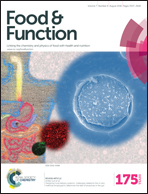Hypolipidemic effects of Myrica rubra extracts and main compounds in C57BL/6j mice†
Abstract
The present study evaluated the antihyperlipidemic activity of myricetin, myricetrin, the alcohol fraction (AF) and the ethyl acetate fraction (EF) obtained from the bark of Myrica rubra (MR) in high-fat and high-cholesterol (HFHC) induced hyperlipidemic C57BL/6j mice. Mice were treated with myricetin, myricetrin, AF and EF with a dose of 130 mg per kg per day for 35 days. After treatment, serum parameters including total cholesterol (TC), triglyceride (TG), low-density lipoprotein cholesterol (LDL-C), total bile acids (TBA), etc., were examined. The results revealed that EF showed the highest weight lowering activity (P < 0.01). All tested samples decreased the levels of the TC, TG, LDL-C, TBA and LPS (lipopolysaccharide) content in the serum of mice to different extents. Liver fat deposition was significantly reduced after myricetin, myricetrin, AF and EF therapy (P < 0.01). Additionally, the cell size of epididymal adipose tissue was also decreased in myricetin, AF and EF groups (P < 0.05). The antihyperlipidemic activity of these samples may be attributed to the inhibition of lipid synthesis via suppressing the expression of HMGCR (3-hydroxy-3-methylglutaryl coenzyme A reductase) and ACC1 (acetyl-CoA carboxylase), promoting the metabolism and excretion of lipids via up-regulating the expression of SREBP2 (sterol regulatory element binding proteins), LDLR (low density lipoprotein receptor), UCP2 (uncoupling protein 2) and CYP7A1 (cholesterol 7α-hydroxylase). These results may provide a powerful foundation for seeking and utilizing Myrica rubra bio-active compounds for the treatment of hyperlipidemia and cardiovascular diseases.


 Please wait while we load your content...
Please wait while we load your content...